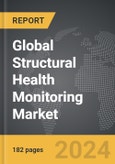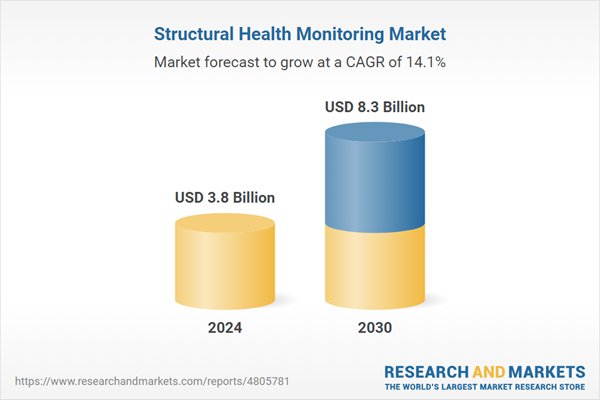The global market for Structural Health Monitoring was valued at US$3.8 Billion in 2024 and is projected to reach US$8.3 Billion by 2030, growing at a CAGR of 14.1% from 2024 to 2030. This comprehensive report provides an in-depth analysis of market trends, drivers, and forecasts, helping you make informed business decisions. The report includes the most recent global tariff developments and how they impact the Structural Health Monitoring market.
Segments: Technology (Wired, Wireless); Offering (Hardware, Software & Services); End-Use (Civil Infrastructure, Aerospace & Defense, Energy, Mining, Other End-Uses).
Geographic Regions/Countries: World; United States; Canada; Japan; China; Europe (France; Germany; Italy; United Kingdom; and Rest of Europe); Asia-Pacific; Rest of World.
The analysts continuously track trade developments worldwide, drawing insights from leading global economists and over 200 industry and policy institutions, including think tanks, trade organizations, and national economic advisory bodies. This intelligence is integrated into forecasting models to provide timely, data-driven analysis of emerging risks and opportunities.
Global Structural Health Monitoring Market - Key Trends & Drivers Summarized
What Is the Significance of Structural Health Monitoring?
Structural health monitoring (SHM) involves the use of various sensors and data collecting systems to assess the condition of buildings, bridges, dams, and other infrastructures. This technology provides real-time data that can help predict and prevent failures, enhance safety, and reduce maintenance costs. The core technologies in SHM include vibration sensors, strain gauges, and acoustic sensors, which monitor changes in the material properties of structures to detect signs of damage or deterioration early. The integration of wireless sensor networks and cloud computing has significantly advanced the capabilities of SHM systems, enabling the remote monitoring of assets and facilitating the efficient management of vast amounts of data.How Does Infrastructure Demand Influence SHM Innovations?
As global infrastructure ages and the economic and human costs of structural failures become more apparent, the demand for robust SHM systems is on the rise. This need is particularly acute in regions with aging infrastructure or those susceptible to natural disasters such as earthquakes and hurricanes. Innovations in SHM are being shaped by the requirements for durability, scalability, and cost-effectiveness. The development of smart materials and nano-technology sensors that can be embedded within structures to provide continuous feedback on their health is a significant advancement. Additionally, the adoption of machine learning algorithms and artificial intelligence in analyzing data enhances the predictive capabilities of SHM systems, enabling preemptive repair and maintenance actions that can save costs and extend the lifespan of infrastructure.What Challenges and Opportunities Exist in the SHM Sector?
Despite its benefits, the adoption of SHM systems faces challenges, primarily related to the initial installation costs and the complexity of integrating various sensor technologies into a cohesive system. However, these challenges present opportunities for innovation, such as the development of cost-effective sensor technologies and standardized software platforms that can integrate data from diverse sensor types. Additionally, there is growing interest in developing autonomous SHM systems that leverage robotics and unmanned aerial vehicles (UAVs) for sensor placement and data collection in hard-to-reach areas.Growth in the Structural Health Monitoring Market Is Driven by Several Factors…
The growth in the structural health monitoring market is driven by several factors, including the escalating need to enhance the longevity and safety of aging infrastructure worldwide. Government regulations and policies promoting public safety and sustainable building practices significantly contribute to the adoption of SHM systems. Technological advancements that lower costs and improve the accuracy and reliability of monitoring equipment are also key growth drivers. Additionally, the increasing sophistication of data analytics and the integration of IoT technologies in SHM solutions expand their applicability and effectiveness. The rising incidence of natural disasters has further underscored the importance of real-time monitoring systems, boosting demand across susceptible regions. Collectively, these factors ensure a dynamic growth trajectory for the SHM market, underlining its critical role in modern infrastructure management.Report Scope
The report analyzes the Structural Health Monitoring market, presented in terms of units. The analysis covers the key segments and geographic regions outlined below.Segments: Technology (Wired, Wireless); Offering (Hardware, Software & Services); End-Use (Civil Infrastructure, Aerospace & Defense, Energy, Mining, Other End-Uses).
Geographic Regions/Countries: World; United States; Canada; Japan; China; Europe (France; Germany; Italy; United Kingdom; and Rest of Europe); Asia-Pacific; Rest of World.
Key Insights:
- Market Growth: Understand the significant growth trajectory of the Wireless Technology segment, which is expected to reach US$3.1 Billion by 2030 with a CAGR of a 14.9%. The Wired Technology segment is also set to grow at 13.7% CAGR over the analysis period.
- Regional Analysis: Gain insights into the U.S. market, valued at $1.0 Billion in 2024, and China, forecasted to grow at an impressive 13.5% CAGR to reach $1.3 Billion by 2030. Discover growth trends in other key regions, including Japan, Canada, Germany, and the Asia-Pacific.
Why You Should Buy This Report:
- Detailed Market Analysis: Access a thorough analysis of the Global Structural Health Monitoring Market, covering all major geographic regions and market segments.
- Competitive Insights: Get an overview of the competitive landscape, including the market presence of major players across different geographies.
- Future Trends and Drivers: Understand the key trends and drivers shaping the future of the Global Structural Health Monitoring Market.
- Actionable Insights: Benefit from actionable insights that can help you identify new revenue opportunities and make strategic business decisions.
Key Questions Answered:
- How is the Global Structural Health Monitoring Market expected to evolve by 2030?
- What are the main drivers and restraints affecting the market?
- Which market segments will grow the most over the forecast period?
- How will market shares for different regions and segments change by 2030?
- Who are the leading players in the market, and what are their prospects?
Report Features:
- Comprehensive Market Data: Independent analysis of annual sales and market forecasts in US$ Million from 2024 to 2030.
- In-Depth Regional Analysis: Detailed insights into key markets, including the U.S., China, Japan, Canada, Europe, Asia-Pacific, Latin America, Middle East, and Africa.
- Company Profiles: Coverage of players such as Campbell Scientific Inc., Rst Instruments Ltd., Geokon Inc., Sensuron, Acellent Technology, Inc. and more.
- Complimentary Updates: Receive free report updates for one year to keep you informed of the latest market developments.
Some of the 14 companies featured in this Structural Health Monitoring market report include:
- Campbell Scientific Inc.
- Rst Instruments Ltd.
- Geokon Inc.
- Sensuron
- Acellent Technology, Inc.
- Avt Reliability
- Cowi A/S
- Pure Technologies Ltd.
- Bridge Diagnostics, Inc.
- Digitexx Data Systems Inc.
- Feac Engineering P.C
- Geocomp Corp.
- Geomotion Singapore
- Sisgeo S.r.l.
- YapiDestek Engineering Ltd. Co.
Tariff Impact Analysis: Key Insights for 2025
Global tariff negotiations across 180+ countries are reshaping supply chains, costs, and competitiveness. This report reflects the latest developments as of April 2025 and incorporates forward-looking insights into the market outlook.The analysts continuously track trade developments worldwide, drawing insights from leading global economists and over 200 industry and policy institutions, including think tanks, trade organizations, and national economic advisory bodies. This intelligence is integrated into forecasting models to provide timely, data-driven analysis of emerging risks and opportunities.
What’s Included in This Edition:
- Tariff-adjusted market forecasts by region and segment
- Analysis of cost and supply chain implications by sourcing and trade exposure
- Strategic insights into geographic shifts
Buyers receive a free July 2025 update with:
- Finalized tariff impacts and new trade agreement effects
- Updated projections reflecting global sourcing and cost shifts
- Expanded country-specific coverage across the industry
Table of Contents
I. METHODOLOGYII. EXECUTIVE SUMMARY2. FOCUS ON SELECT PLAYERSIII. MARKET ANALYSISIV. COMPETITION
1. MARKET OVERVIEW
3. MARKET TRENDS & DRIVERS
4. GLOBAL MARKET PERSPECTIVE
UNITED STATES
CANADA
JAPAN
CHINA
EUROPE
FRANCE
GERMANY
ITALY
UNITED KINGDOM
REST OF EUROPE
ASIA-PACIFIC
REST OF WORLD
Companies Mentioned (Partial List)
A selection of companies mentioned in this report includes, but is not limited to:
- Campbell Scientific Inc.
- Rst Instruments Ltd.
- Geokon Inc.
- Sensuron
- Acellent Technology, Inc.
- Avt Reliability
- Cowi A/S
- Pure Technologies Ltd.
- Bridge Diagnostics, Inc.
- Digitexx Data Systems Inc.
- Feac Engineering P.C
- Geocomp Corp.
- Geomotion Singapore
- Sisgeo S.r.l.
- YapiDestek Engineering Ltd. Co.
Table Information
| Report Attribute | Details |
|---|---|
| No. of Pages | 182 |
| Published | April 2025 |
| Forecast Period | 2024 - 2030 |
| Estimated Market Value ( USD | $ 3.8 Billion |
| Forecasted Market Value ( USD | $ 8.3 Billion |
| Compound Annual Growth Rate | 14.1% |
| Regions Covered | Global |









